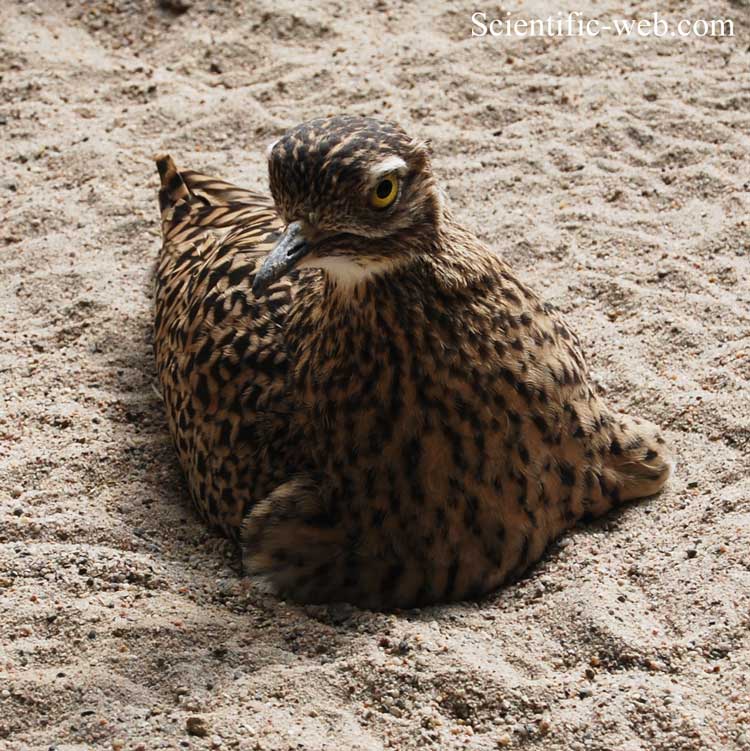
Burhinus capensis, Photo: Michael Lahanas
Superregnum: Eukaryota
Cladus: Unikonta
Cladus: Opisthokonta
Cladus: Holozoa
Regnum: Animalia
Subregnum: Eumetazoa
Cladus: Bilateria
Cladus: Nephrozoa
Superphylum: Deuterostomia
Phylum: Chordata
Subphylum: Vertebrata
Infraphylum: Gnathostomata
Megaclassis: Osteichthyes
Cladus: Sarcopterygii
Cladus: Rhipidistia
Cladus: Tetrapodomorpha
Cladus: Eotetrapodiformes
Cladus: Elpistostegalia
Superclassis: Tetrapoda
Cladus: Reptiliomorpha
Cladus: Amniota
Classis: Reptilia
Cladus: Eureptilia
Cladus: Romeriida
Subclassis: Diapsida
Cladus: Sauria
Infraclassis: Archosauromorpha
Cladus: Crurotarsi
Divisio: Archosauria
Cladus: Avemetatarsalia
Cladus: Ornithodira
Subtaxon: Dinosauromorpha
Cladus: Dinosauriformes
Cladus: Dracohors
Cladus: Dinosauria
Ordo: Saurischia
Cladus: Eusaurischia
Subordo: Theropoda
Cladus: Neotheropoda
Cladus: Averostra
Cladus: Tetanurae
Cladus: Avetheropoda
Cladus: Coelurosauria
Cladus: Tyrannoraptora
Cladus: Maniraptoromorpha
Cladus: Maniraptoriformes
Cladus: Maniraptora
Cladus: Pennaraptora
Cladus: Paraves
Cladus: Eumaniraptora
Cladus: Avialae
Infraclassis: Aves
Cladus: Euavialae
Cladus: Avebrevicauda
Cladus: Pygostylia
Cladus: Ornithothoraces
Cladus: Ornithuromorpha
Cladus: Carinatae
Parvclassis: Neornithes
Cohors: Neognathae
Cladus: Neoaves
Ordo: Charadriiformes
Subordo: Charadrii
Familia: Burhinidae
Genus: Burhinus
Species: Burhinus capensis
Subspecies: B. c. capensis – B. c. damarensis – B. c. dodsoni – B. c. maculosus
Name
Burhinus capensis (Lichtenstein, 1823)
Synonymy
Oedicnemus capensis (protonym)
References
Lichtenstein, M.H.C. 1823. Verzeichniss der Doubletten des zoologischen Museums der Königl. Universität zu Berlin nebst Beschreibung vieler bisher unbekannter Arten von Säugethieren, Vögeln, Amphibien und Fischen. 118 pp. Königl. Preuss. Akad. Wiss./ T. Trautwein, Berlin. : 69 #715 BHL DOI: 10.5962/bhl.title.40281 Reference page.
Vernacular names
Afrikaans: Gewone dikkop
العربية: كروان منقط
azərbaycanca: Kap pərttəgözü
brezhoneg: Bourlagad ar C'hab
català: Torlit pigallat
čeština: Dytík skvrnitý
Cymraeg: Rhedwr brych
dansk: Plettet Triel
Deutsch: Kaptriel
English: Spotted Thick-knee
Esperanto: Kaba trielo
español: Alcaraván de El Cabo
eesti: Täpik-jämejalg
suomi: Suomupaksujalka
français: Oedicnème tachard
magyar: Fokföldi ugartyúk
italiano: Occhione del Capo
日本語: ケアプイシチドリ
lietuvių: Dėmėtasis storkulnis
Nederlands: Kaapse Griel
norsk: Flekktriel
Diné bizaad: Goditání łikizhígíí
polski: Kulon plamisty
português: Alcaravão do Cabo
русский: Капская авдотка
slovenčina: Ležiak škvrnitý
chiShona: Gwarimutondo
SiSwati: Umunkonkoni
Sesotho: Khoho-ea-lira
svenska: Fläcktjockfot
Kiswahili: Chekehukwa
Setswana: Kgoadirê
Türkçe: Benekli kocagöz
Xitsonga: Mtshikuyana
isiXhosa: Ingqangqolo
中文: 斑石鸻
isiZulu: umBangaqhwa
The spotted thick-knee (Burhinus capensis), also known as the spotted dikkop or Cape thick-knee, is a wader in the family Burhinidae. It is native to tropical regions of central and southern Africa.
Description
The spotted thick-knee, which can reach up to 45.5 cm (17.9 in) in height, has long legs and brown-and-white speckled plumage which provides camouflage, making it difficult to spot the bird in the grasslands and savannas where it roams. Its head is large and round with a prominent yellow eye and a short, stout beak. When in flight or standing in a characteristic position with its wings raised, it shows a striking contrasting pattern. Its legs are long and yellow and the tibiotarsal joint is expanded, giving it the name "thick-knee".[2][3]
Behaviour
The spotted thick-knee is nocturnal and squats on the ground during the daytime, making it difficult to spot. It hunts exclusively on the ground, feeding on insects, small mammals and lizards.
Breeding
Usually 2 eggs are laid at a two-day interval. They measure some 5.2 cm × 3.8 cm. They are marked with sepia brown and ash grey on a pale, clay-coloured background.[4]
It nests on the ground, lining a scrape with grasses, feathers, pebbles and twigs. The female typically lays two eggs, and males and females rear the offspring together, with both bringing food back to the nest. The birds will defend the nest and adopt a defensive pose with wings spread and tail cocked and will even peck an intruder. Sometimes they will fake injuries to lead predators away from the nest.[2][3]
Distribution
The spotted thick-knee is native to the grasslands and savannas of sub-Saharan Africa. Its range extends from Senegal, Mali and Mauritania in the west to Ethiopia, Kenya, Tanzania and South Africa in the east and south.[1]
Status
The spotted thick-knee has a very extensive range, and its population is believed to be stable. For these reasons, the IUCN has rated it as being of "Least Concern".[1]
Gallery
A five day old chick
A five day old chick
Adult's defensive pose
Adult's defensive pose
Scanning the sky for raptors
Scanning the sky for raptors
Cooling down by panting
Cooling down by panting
References
BirdLife International (2016). "Burhinus capensis". IUCN Red List of Threatened Species. 2016: e.T22693589A93414268. doi:10.2305/IUCN.UK.2016-3.RLTS.T22693589A93414268.en. Retrieved 12 November 2021.
"Spotted Dikkop Fact Sheet". Lincoln Park Zoo.
Broekhuysen, GJ (1836). A description and discussion of threat- and anxiety-behaviour of Burhinus capensis (Lichtenstein) during incubation. Brill Archive. pp. 240–1.
Keith, Stuart; Urban, Emil K.; Fry, C. Hilary (1986). The Birds of Africa, Volume II. Academic Press. pp. 204–205. ISBN 0-12-137302-9.
Retrieved from "http://en.wikipedia.org/"
All text is available under the terms of the GNU Free Documentation License

